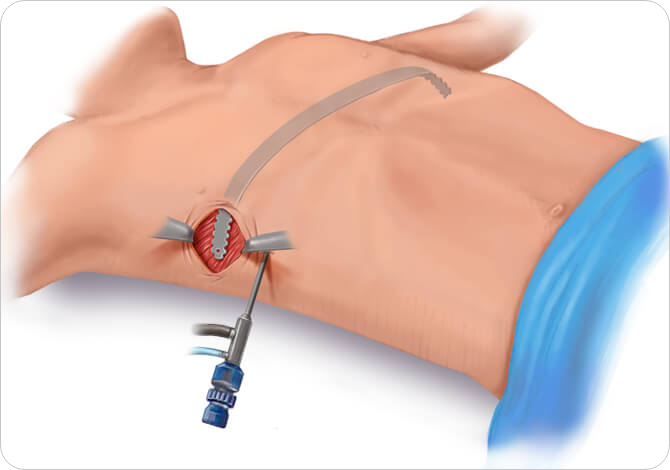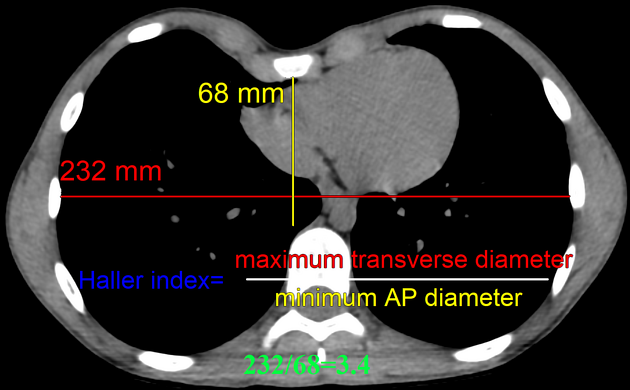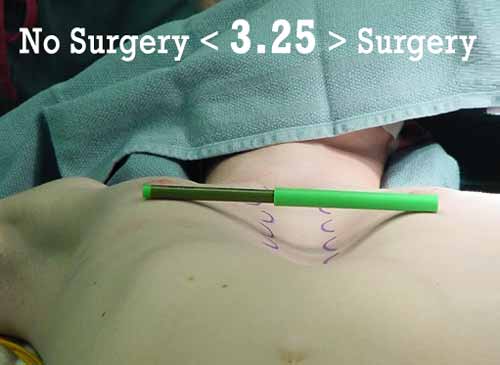lazza
Bronze
- Joined
- Dec 2, 2023
- Posts
- 460
- Reputation
- 359
Let's say an hypothetical test subject has to undergo a thoracic ct scan for his pectus excavatum to calculate his haller index and he needs to find the best "strategy" to increase the haller index, what would you advise?
but first a quick introduction to pectus excavatum and a better understanding on how the haller index is used in the context of insurance coverage:
So that you know understand gow this ratio is used to determin if you are eligable for surgery you can also see that it's possible to "mechanicaly" worsen the ratio in order register a higer value and obtain the surgery.
Since it's a pure anatomical measurement, one could slouch his entire posture during the scan and subtly allow their shoulders to roll forward and their upper back to curve slightly. While lying in the scanner, the subject intentionally rounds their shoulders and upper back (thoracic kyphosis), pushing the sternum downward and forward. They may also subtly tilt their pelvis to arch the lower back, further altering spinal alignment.
posture is huge. Slumping the shoulders forward and hunching the back genuinely and physically restricts the ability of the lungs and rib cage to expand. It's not faking; it's actively creating a real, temporary restrictive defect for the duration of the test.
also keep in mind that exam is performed with your arms near your head, but despite having their arms raised, the subject can attempt isometric contractions. This includes:
- Pectoral Flex: Subtly trying to contract the pectoral muscles to pull the humeral heads forward and inward, potentially deepening the fossa.
- Scapular Protraction: Pushing the shoulders forward against the table to round the upper back.
it's also possible to do this: While exhaling is legitimate, forcefully exhaling and bearing down (like you're straining to lift something) is a Valsalva maneuver. This can change intrathoracic pressure and heart dynamics in ways that are not representative of your normal state
So Instead of a neutral breath-hold, the person would force all the air out of their lungs and then slump their shoulders and upper back forward during the CT scan. This artificially collapses the chest cavity further, minimizing the front-to-back distance. This maximally depresses the diaphragm and reduces the AP diameter.
Disclaimer: This is not misrepresentation or fraud. A patient with a severe Haller Index will genuinely experience these physical limitations due to the heart and lung compression caused by their anatomy.
You guys have been nominated after i foud you interacting in other pectus discussions @Bryce @cutecel1337 @Unfortunate001 @salemmogs @NevaSure @kyphoscoliosis @garoupilled_ @CopingCel @lurks)
@Bryce @cutecel1337 @Unfortunate001 @salemmogs @NevaSure @kyphoscoliosis @garoupilled_ @CopingCel @lurks)
What i wanted to ask you is to share your experience with this BS and for the others tell me what they think and propose certain creative solutions to overcome the Haller problem
but first a quick introduction to pectus excavatum and a better understanding on how the haller index is used in the context of insurance coverage:
Pectus excavatum is a chest wall deformity where the breastbone sinks into the chest. This can create a noticeable dent or caved-in appearance.
It's a very sub optimal condition that requires surgery to fix it

It's a very sub optimal condition that requires surgery to fix it

For many with pectus excavatum, the sunken chest isn't a life sentence. There's a well-established, minimally invasive surgical solution known as the Nuss procedure.
The concept is brilliantly simple: surgeons insert a customshaped, curved metal bar under the sternum. Using a small scope for guidance, they then flip the bar into position, which immediately pushes the depressed chest wall out to a normal shape.
It's important to know that health insurance typically covers the surgical correction of pectus excavatum only if it's deemed a medically necessary procedure to restore function, not a cosmetic one.
To determine if a patient is eligible for insurance coverage, doctors use an objective measurement called the Haller Index. This is a standardized way to quantify the severity of the chest deformity. Generally, a patient must have a Haller Index greater than 3.25 to be considered for coverage, indicating a significant physical compression.

The concept is brilliantly simple: surgeons insert a customshaped, curved metal bar under the sternum. Using a small scope for guidance, they then flip the bar into position, which immediately pushes the depressed chest wall out to a normal shape.
It's important to know that health insurance typically covers the surgical correction of pectus excavatum only if it's deemed a medically necessary procedure to restore function, not a cosmetic one.
To determine if a patient is eligible for insurance coverage, doctors use an objective measurement called the Haller Index. This is a standardized way to quantify the severity of the chest deformity. Generally, a patient must have a Haller Index greater than 3.25 to be considered for coverage, indicating a significant physical compression.

The Haller Index is a simple ratio calculated from a CT scan of the chest. It measures the severity of the indentation by comparing two internal distances:


- The Transverse Diameter: The widest horizontal distance across the inside of the ribcage.
- The Anteroposterior (AP) Diameter: The shortest distance from the backbone (vertebrae) to the sternum at its deepest point of depression.


So that you know understand gow this ratio is used to determin if you are eligable for surgery you can also see that it's possible to "mechanicaly" worsen the ratio in order register a higer value and obtain the surgery.
Since it's a pure anatomical measurement, one could slouch his entire posture during the scan and subtly allow their shoulders to roll forward and their upper back to curve slightly. While lying in the scanner, the subject intentionally rounds their shoulders and upper back (thoracic kyphosis), pushing the sternum downward and forward. They may also subtly tilt their pelvis to arch the lower back, further altering spinal alignment.
posture is huge. Slumping the shoulders forward and hunching the back genuinely and physically restricts the ability of the lungs and rib cage to expand. It's not faking; it's actively creating a real, temporary restrictive defect for the duration of the test.
also keep in mind that exam is performed with your arms near your head, but despite having their arms raised, the subject can attempt isometric contractions. This includes:
- Pectoral Flex: Subtly trying to contract the pectoral muscles to pull the humeral heads forward and inward, potentially deepening the fossa.
- Scapular Protraction: Pushing the shoulders forward against the table to round the upper back.
it's also possible to do this: While exhaling is legitimate, forcefully exhaling and bearing down (like you're straining to lift something) is a Valsalva maneuver. This can change intrathoracic pressure and heart dynamics in ways that are not representative of your normal state
So Instead of a neutral breath-hold, the person would force all the air out of their lungs and then slump their shoulders and upper back forward during the CT scan. This artificially collapses the chest cavity further, minimizing the front-to-back distance. This maximally depresses the diaphragm and reduces the AP diameter.
Disclaimer: This is not misrepresentation or fraud. A patient with a severe Haller Index will genuinely experience these physical limitations due to the heart and lung compression caused by their anatomy.
You guys have been nominated after i foud you interacting in other pectus discussions
What i wanted to ask you is to share your experience with this BS and for the others tell me what they think and propose certain creative solutions to overcome the Haller problem
Last edited:


